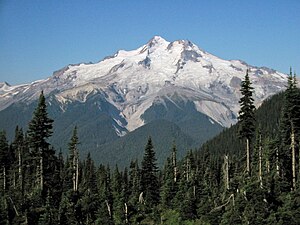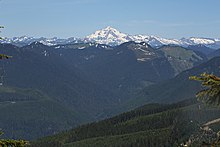Glacier Peak
| Glacier Peak | ||
|---|---|---|
|
Glacier Peak , view of eastern slope |
||
| height | 3213 m | |
| location | Washington , USA | |
| Mountains | Cascade chain | |
| Coordinates | 48 ° 6 '45 " N , 121 ° 6' 50" W | |
|
|
||
| Type | Stratovolcano | |
| rock | Dazit | |
| Age of the rock | Pleistocene | |
| Last eruption | 17th or 18th century | |
| First ascent | 1898 by Thomas Gerdine | |
The Glacier Peak (English glacier summit ; in the Sauk dialect of the Lushootseed language Tda-ko-buh-ba or Takobia ) in the north of the state of Washington , USA , is an active stratovolcano of the Cascade Range .
Unlike some other volcanoes in the Pacific Northwest , Glacier Peak is not particularly visible from the nearest metropolitan areas, and its tourist attractions and dangers are often overlooked. The volcano has seen some of the largest eruptions in Washington state since the last Ice Age . The eruptions took place in six series during this time, the last being 200 to 300 years ago. Glacier Peak is located in Snohomish County about 100 km northeast of Seattle, hardly further from the city than Mount Rainier . But unlike this, the volcano rises only up to 1000 m higher than the surrounding peaks, making it one of many in a series of high mountains when viewed from Puget Sound .
geology
The summit area, including the disappointment peak , is the remains of lava domes from prehistoric times. Remnants of pyroclastic flows can be seen on the mountain slopes, and traces of volcanic ash , especially on the eastern slope .
The mountain slopes have several kilometers of deposits of lahars and debris flows . The oldest deposit with 14,000 years extends about 35 km from the western slope and through the valley of the White Chuck River to its confluence with the Sauk River. At about 1,800 m altitude on Glacier Peak there are several cinder and ash cones , as well as three thermal springs called Gamma , Kennedy and Sulfur .
The stratovolcano is the fourth highest mountain in Washington state. As part of the Cascade Volcanic Arc, it was created by subduction of the Juan de Fuca plate under the North American plate . The plates converge at a rate of four centimeters per year. Despite the height of 3212 m, the Glacier Peak is quite small for a stratovolcano. The summit is so high because the actual volcano is on a high mountain range. This volcanic part of Glacier Peak is only 500 to 1000 m higher than the chain below.
Volcanic activity
Like Mount St. Helens , Glacier Peak forms very viscous magma (see also: Dacite ) that does not flow out of the volcanic vent, but collects inside the mountain, which ultimately leads to an explosion. By applying radiocarbon dating to pyroclastic sediments at the foot of the mountain, it was determined that Glacier Peak was around 1700, 1300, 900, 200, 850 BC. BC, 3150 BC BC and 3550 BC Must have broken out. Three of the eruptions were between levels 2 to 4 according to the volcanic explosive index . Characteristic of these eruptions are a first eruption through the volcanic vent , followed by a stronger explosion. The material that was ejected varied. Sometimes lahars arose , sometimes pyroclastic flows or lava domes .
In the river valleys around Glacier Peak there are thick layers with remains of lahars, some of which are tens of kilometers away from the associated eruption. In the eruptions of 5900 and 1800 years ago, the lahars made their way into Puget Sound . During the eruptions, part of the sputum fell in the vicinity. Most of the ash, however, was carried to great heights and driven away by the wind. The ash layers formed by this ash are about 30 cm thick near the city of Chelan . At Missoula , Montana , they have a height of 7.6 mm.
glacier
Eleven large glaciers cover the summit area of Glacier Peak. When CE Rusk first saw them in 1906, they had already shrunk, but were still very expanded. From the Little Ice Age to 1958, the glacier front of the glaciers on Glacier Peak had receded by an average of 1,640 meters. Richard Hubley noticed increasing glaciation since the early 1950s. Before that, the glaciers had melted very quickly for about thirty years. The increasing glaciation in the middle of the 20th century was caused by more abundant winter precipitation and lower temperatures in summer. The time of glacier formation lasted until around 1979. Between 1984 and 2005 the glacier fronts retreated by an average of 310 m. The Milk Lake Glacier on the north slope of Glacier Peak completely disappeared in the 1990s.
history
Washington's snow-capped volcanoes influenced the legends and languages of Native Americans, and they also drew the attention of American and European explorers of the late 18th and early 19th centuries . As early as the 1790s , Mount Baker , Mount Rainier, and Mount St. Helens were mentioned in the first written descriptions of the Columbia River and Puget Sound regions . In 1805, noted Lewis and Clark to Mount Adams . During the middle of the 19th century, the volcanoes were marked on the maps.
Glacier Peak, however, was not known to the settlers until the natives described to the naturalist George Gibbs in the 1850s that another slightly smaller peak would smoke north of Mount Rainier. Until 1898, no map showing Glacier Peak was published.
Web links
items
- US Geological Survey (English)
- Peakware.com (English)
- Bivouac.com (English)
- SummitPost.org (English)
Photos and cards
Individual evidence
- ↑ Jean Fish Bedal et al. Edith Bedal (2000): Two Voices - A History of the Sauk and Suiattle People, and Sauk Country Experiences. Astriba R. Blukis Onat
- ^ Glacier Peak: Summary , Smithsonian Institution , accessed December 14, 2010
- ↑ a b c d Larry Mastin u. Richard Waitt: Glacier Peak - History and Hazards of a Cascade Volcano . In: United States Geological Survey . 2000. Retrieved December 14, 2010.
- ^ JE Beget (1982): Postglacial volcanic deposits at Glacier Peak, Washington, and potential hazards from future eruptions; a preliminary report. ( USGS )
- ↑ Global Volcanism Program: Glacier Peak - Synonyms and Subfeatures , Smithsonian Institution , accessed December 14, 2010
- ^ Brantley (1994): Volcanoes of the United States: USGS General Interest Publication. (USGS)
- ↑ Swanson, et al. (1989): Cenozoic Volcanism in the Cascade Range and Columbia Plateau, Southern Washington and Northernmost Oregon: AGU Field Trip Guidebook T106. (USGS)
- ^ Wood and Kienle, eds. (1990): Volcanoes of North America - United States and Canada , Cambridge University Press , pp. 156-158, ISBN 978-0521438117 .
- ↑ Glacier Peak: Eruptive History , Smithsonian Institution , accessed December 14, 2010
- ↑ Pelto, Mauri S .: North Cascade Glacier Climate Project ( Memento of 18 May 2013 Webcite ), Nichols College, accessed 14 December 2010




